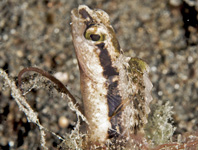Abstract
A new fangblenny, Adelotremus deloachi, is described on the basis of three specimens, 29‒35 mm SL, from Bali and Lembeh Strait, Indonesia. All these specimens were collected in 10‒17 m depth on sandy slopes. The new species differs from Adelotremus leptus, its Red Sea and only congener, in having a pair of mid-dorsal supratemporal pores (vs. a single pore), dorsal-fin spines X (vs. IX) and precaudal and caudal vertebra 12 + 23 (vs. 13 + 19). The discovery of a second species requires slight modification of the diagnosis of the genus. Unlike the five other nemophine genera, Adelotremus differs most notably in having the third infraorbital bone and associated sensory pores absent, and the combination of ventral margin of gill opening opposite the dorsalmost 5th or 6th pectoral-fin ray, total dorsal-fin elements 28‒29 and interorbital pores 2. With a total of four specimens of Adelotremus, it is now apparent that several features of the cephalic pore arrangement of the genus are different from that found in Petroscirtes, its presumed sister genus. Recent color photographs indicate that both species of Adelotremus exhibit marked sexual dichromatism with males having a conspicuous ocellus anteriorly in the dorsal fin that is absent in females.
References
Smith-Vaniz, W.F. (1976) The saber-toothed blennies, tribe Nemophini (Pisces: Blenniidae). Academy of Natural Sciences of Philadelphia, Monograph, 16, 1–196.
Smith-Vaniz, W.F. & Rose, J.M. (2012) Adelotremus leptus, a new genus and species of sabertooth blenny from the Red Sea (Teleostei: Blenniidae: Nemophini). Zootaxa, 3249, 39–46.

